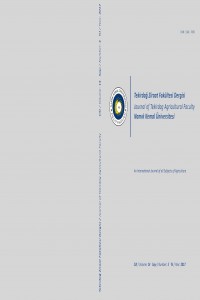Abstract
Fındık kepeği, fındık tanesini tamamen saran ve
iç fındığın kavrulması sırasında yan ürün olarak açığa çıkan ince ve kahverengi
perisperm tabakasıdır. Fındık kepeğinin antioksidan özellikleri yüksek olup,
diyet lif olarak da değerlendirilmektedir. Fındık kepeğinin bu özellikleri
sebebiyle ekmek, kurabiye ve kek yapımında kullanılması, üretilen fırıncılık
ürünlerinin bazı fizikokimyasal ve duyusal özelliklerinin tespit edilmesi için
mevcut çalışma yürütülmüştür. Çalışma kapsamında buğday ununa % 4, 6, 8 ve 10
seviyesinde fındık kepeği ilave edilerek karışım unlar elde edilmiştir. Unlara
ait reolojik özellikler ekstensograf ve farinograf ölçümleri ile belirlenmiş
olup, fındık kepeği miktarı arttıkça unun su tutma kapasitesinin (%61,8’den
%67,1’e), gelişme zamanının (4,3 dakikadan 10,7 dakikaya) ve stabilitesinin
(8,2 dakikadan 17,2 dakikaya) arttığı tespit edilmiştir. Fındık kepeğine ait
toplam fenolik madde içeriği kuru bazda 209,750 mg GAE/g olarak bulunmuştur.
%10 fındık kepeği içeren unla üretilen ekmek, kurabiye ve keklerde fenolik
madde içeriği sırasıyla 19,427, 9,777 ve 13,126 mg GAE/g olarak belirlenmiştir.
Duyusal analiz sonuçlarına göre renk, koku ve tat yönünden en yüksek (P < 0,05) skoru elde eden kurabiye
örnekleri %8 fındık kepeği içeren örnekler olurken, çalışma kapsamında üretilen
tüm ekmek ve kek numuneleri panelistler tarafından aynı oranda toplam beğeni
skoru elde etmiştir (P>0,05). Sonuç olarak fırıncılık ürünleri üretiminde
fındık kepeği ilavesinin yeni ürünlerin üretiminde önemli bir alternatif
olabileceği belirlenmiştir.
Keywords
References
- Gawlik-Dziki, U., M. Świeca, D. Dziki, B. Baraniak, J. Tomiło, J. Czyż, 2013. Quality and antioxidant properties of breads enriched with dry onion (Allium cepa L.) skin. Food Chemistry, 138 (2-3), 1621–1628.
Abstract
Hazelnut testa is the thin brown perisperm which wraps
the hazelnut kernels, and obtained as a by-product after the roasting process
of hazelnut. It has good antioxidant and dietary fiber properties. Hence, the
present study was carried out to utilize hazelnut testa in the production of
bread, cookie and cake, and evaluate some physicochemical and sensorial
properties of the samples enriched
with hazelnut testa. The wheat flour samples substituted with hazelnut testa at
levels of 4, 6, 8 and 10 % were used in product recipes. The rheological
properties of flour mixes were evaluated using extensograph and farinograph
measurements. Increased amounts of testa resulted to higher water absorption
(61.8 to 67.1%), development time (4.3 to 10.7 min) and stability (8.2 to 17.2
min) values of flour. Total phenolic content of hazelnut testa was determined
to be 209.750 mg GAE/ g dry matter. Bread, cookie and cake samples produced
using flour containing 10% testa were determined to contain 19.427, 9.777 and
13.126 mg GAE/ g dry matter, respectively. Cookies prepared with flour
containing 8% testa had the highest scores for color, smell and taste (P < 0.05) where the panelists liked
all breads and cakes according to overall acceptability equally (P > 0.05). Consequently, the
use of flour mixes enriched with hazelnut testa could
be an effective way to put functional bakery products in the food market.
Keywords
References
- Gawlik-Dziki, U., M. Świeca, D. Dziki, B. Baraniak, J. Tomiło, J. Czyż, 2013. Quality and antioxidant properties of breads enriched with dry onion (Allium cepa L.) skin. Food Chemistry, 138 (2-3), 1621–1628.
Details
| Journal Section | Articles |
|---|---|
| Authors | |
| Publication Date | October 10, 2017 |
| Submission Date | February 9, 2017 |
| Acceptance Date | September 12, 2017 |
| Published in Issue | Year 2017 Volume: 14 Issue: 3 |


